UNIT 5: HEALTH AND SANITATION
Key competence: To use language learnt in the context of health and sanitation
Introductory Activity Picture observation and interpretation
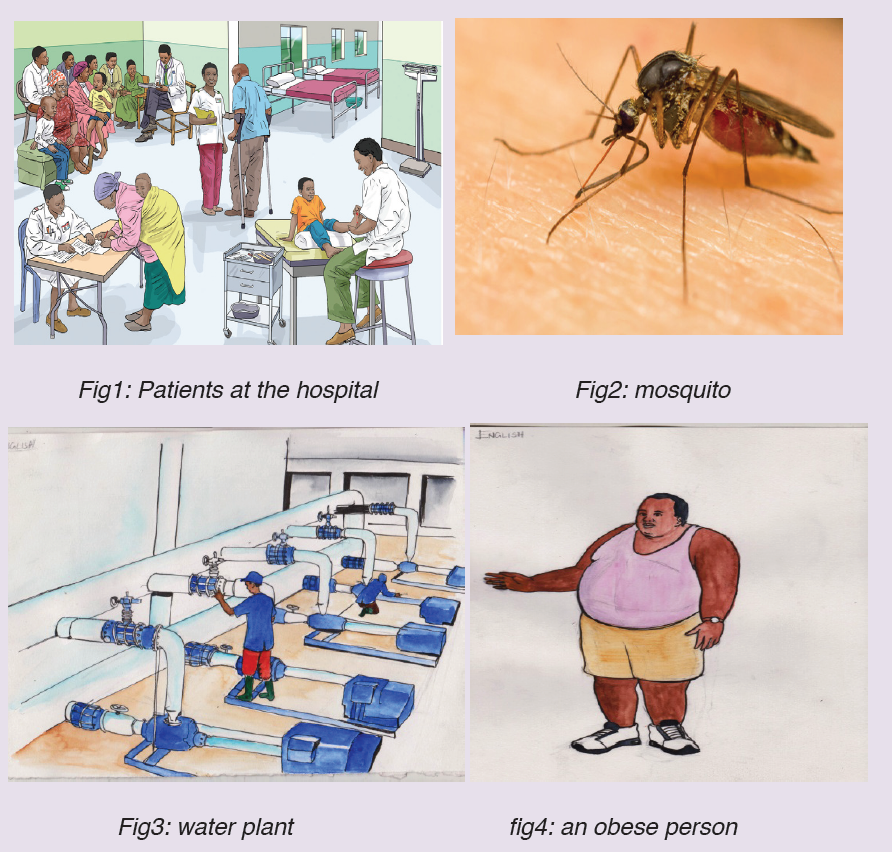
Look at the pictures above answer the questions below:
1. What are the most common illnesses in Rwanda?
2. State at least three communicable diseases.
3. Which sickness can be caused by the insect in fig 2?
4. What do you think is described in fig 3?
5. Mention at least one coronary disease you know.
6. The man in fig4 is very fat. Do you think it is a health related problem? Explain.
5.1. Describing illnesses and diseases and pandemics
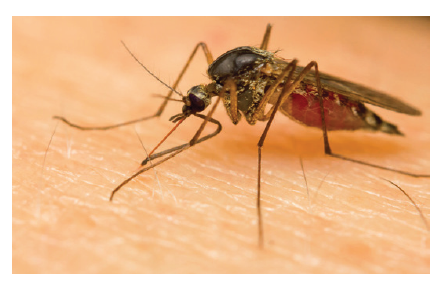
5.1.1. Learning activity: Reading and text analysis
• Text: Types of diseases in Rwanda
There are different types of diseases in Rwanda. Some diseases affect the majority of Rwandans. Others affect only a small number of the population.
The most common diseases in Rwanda today are malaria, HIV/AIDS, tuberculosis, typhoid or typhoid fever. Many Rwandans also suffer from amoebic dysentery, Hepatitis B and C and the common cold.
Some communicable diseases, like typhoid and amoebic dysentery, are waterborne. This means you get these diseases when you drink water that is not clean and boiled. Diseases like tuberculosis and the common cold are airborne. The bacteria or viruses are ejected into the air via coughs or sneezes. When you breathe in this air, you become infected.
Hepatitis B and C and HIV/AIDS are transmitted through body fluids.
Infections and diseases, such as hepatitis are most often carried through the semen and blood of infected persons. Malaria is transmitted through the bite of a female anopheles mosquito. It injects infected blood into your body when it bites you.
Communicable diseases are caused by causative agents. Typhoid, amoebic dysentery and tuberculosis are caused by bacteria. Hepatitis B and C, HIV/AIDS and the common cold are caused by viruses. Malaria is caused by a parasite called plasmodia.
Other diseases are sometimes referred to as lifestyle diseases. These are steadily increasing in Rwanda. The best examples are coronary disease, cancer, diabetes, obesity and mental illnesses.
Coronary diseases, diabetes, obesity and mental illnesses can be caused by a combination of genetics and lifestyle. Cancer results from the malfunctioning of body cells. The substances that cause cancer are called carcinogens.
A carcinogen may be a chemical substance, such as certain molecules in tobacco smoke. The cause of cancer may be environmental agents, viral or genetic factors. We should bear in mind, though, that in the majority of cancer cases we cannot attribute the disease to a single cause.
• Comprehension questions
1. List three of the most common diseases in Rwanda.
2. What are communicable diseases?
3. What is a ‘causative agent’?
4. What causes malaria?
5. How can you avoid getting typhoid fever or amoebic dysentery?
6. How can you avoid getting Hepatitis B or C and HIV/AIDS?
7. Which diseases are steadily increasing in Rwanda?
8. Name two lifestyle diseases.
9. What is meant by ‘lifestyle diseases’?
10. What disease is caused by body cells that malfunction?
• Vocabulary activities:
1. Use the dictionary and thesaurus to look up the missing meanings of the words/phrases in the table below. Copy the table into your book and fill in the blank spaces.

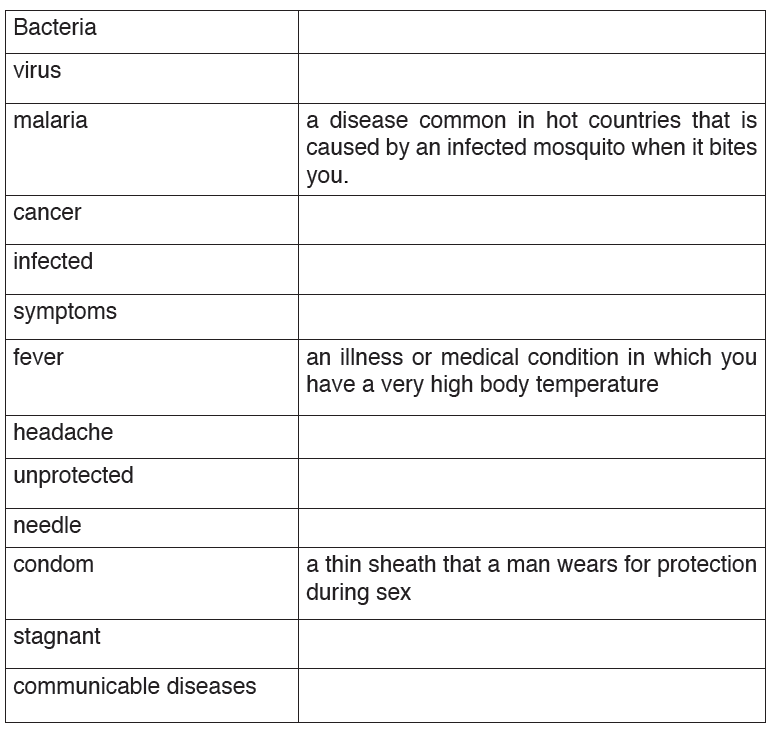
2. Write one sentence for each word/phrase to illustrate how they are used.
5.1.2 Application activities
1. Write a paragraph explaining what communicable diseases are and how they can be prevented.
• Notes
• A paragraph is normally a body of sentences developing one main point. Thus, each sentence of the paragraph should explain more on the main point. They shouldn’t raise a different point.
• Every paragraph should have a topic sentence. A topic sentence gives the main idea of a paragraph. It usually occurs as the first
sentence of the paragraph.
• Every sentence in a paragraph must be grammatically correct.
• After explanatory sentences which give details about the main topic, there is always need to have a closing sentence. This should sum up the topic in the paragraph.
• A good paragraph must focus on the main idea, presented logically and should have a sense of coherence and completeness.
2. Debate on the following motion:
Schools should conduct mandatory HIV testing on their students.
• Definition of debate
A debate is a structured contest in form of oral arguments about an issue or a topic. A formal debate involves two teams expressing their arguments on the topic. Normally, there is a team which proposes or argues in support of the topic while the second team is on the opposition side. Each team consists of two or more main speakers.
• The rules of debate
The debate is always governed by a number of rules as explained below:
• Each team is expected to advance two or three arguments, and two to three rebuttal speeches. The proposing team gives its argument first, followed by the rebuttals from the opposing team. There is always a winding up speech or summarized argument by a selected member of each team.
• The first speaker on each side is supposed to define the key words or terms of the motion as the basis of advancing his or her points.
• If the opposing side challenges the correctness of a definition advanced by the proposer, the opposing team provides its view on the matter.
• Each team of the class debate must advocate or argue in support of his or her view on the topic.
• In order to establish an assertion, a team must support its arguments with enough evidence and logic to convince the judges. Facts must be accurate. Visual materials are permissible to convince the judges.
• In case of a query, the question should be clear and relevant to the motion of the debate.
• As a matter of procedure, each speaker is expected to respond to questions as soon as he or she concludes his or her presentation speech. The speaker concerned may respond to the question personally, although any other member of his or her team can come in to assist.
• If anyone, whether in the audience or among the main speakers, feels unconvinced by a speaker’s argument, he or she is at liberty to interrupt the speaker by raising a point of information. However, the chairman of the debate is also at liberty to either permit or object to the point of interruption.
• The decision about the winning side will be entirely based on the arguments made and points awarded by a team of juries or judges.
Adapted from George H.W. Wilson (1957) Competitive Debate: Rules and Techniques, New York: McCoy Musgravehttp://homepage.ntu.edu.tw/~karchung/debate1.htm retrieved on September 5th, 2019
• Important prerequisites and tasks for debate
Team members should:
• Research on the topic and prepare logical arguments.
• Gather supporting evidence and examples to back their arguments.
• Anticipate counter arguments and prepare rebuttals or responses.
• Plan the order and ideas or points with which to argue and support their points of view.
5.2 Talking about sanitation and related tools
5.2.1 Learning activity: Reading and text analysis
Read the text below and answer the questions that below:
• Text 1: Water and sanitation are human rights.
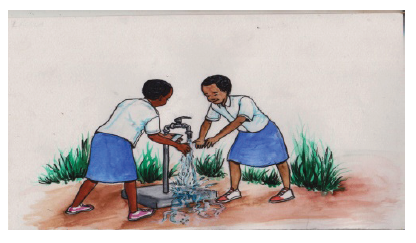
Sanitation refers to conditions relating to public health, especially the provision of clean drinking water and adequate sewage disposal. Universal access to safe water, sanitation and hygiene services are priorities in Rwanda.
Washing hands is critically linked to improved nutrition, good health, gender equality, economic growth, and environmental management.
Poor sanitary conditions causes diarrhea and intestinal parasites and environmental enteropathy and have complex and reciprocal links to malnutrition in children. Existing evidence demonstrates that poor sanitation and hygiene conditions can affect a child’s nutritional status via at least three direct pathways (i) diarrheal diseases; (ii) intestinal parasites; and (iii)
environmental enteropathy. Malnutrition weakens the body’s defenses and makes children more vulnerable to diseases. At the same time, diarrhea and intestinal parasites contribute to malnutrition by causing decreased food intake, impaired nutrient absorption and direct nutrient losses.
In Rwanda, only 57 per cent of the population access safe drinking water that is within 30 minutes of their home. When children are forced to spend time collecting water, it keeps them out of school. This is an issue especially for girls, who are often expected to take on the majority of household tasks.
Even if water is available near the home, that water is often not safe to drink.
When children drink contaminated water, they risk severe illness and even death from water bone diseases.
Basic sanitation means that every household has its own toilet and does not share with another household. These toilets should also keep human waste out of contact with people. Only 64 per cent of the population in Rwanda have access to these sanitation services.
Just 5 per cent of households in Rwanda have a place for family members to wash their hands with soap. Hand washing with soap at critical moments is essential for good health, especially in children.
As a solution UNICEF’s WASH program in Rwanda aims to ensure that more households and communities use safe and sustainable water and sanitation services, and that children and families practice good hygiene.
UNICEF supports the Government of Rwanda to ensure that every household:
Uses safe and clean water near the home, a hygienic and private latrine and practices hand washing with soap, especially after using the toilet and before handling food.
Adapted from https://www.unicef.org/rwanda/water-sanitation-and-hygiene
• Comprehension questions
1. How do you think hand washing can be linked to improved nutrition?
2. Explain the consequences of using dirty water.
3. Which consequences school children who don’t have water near their home are likely to face?
4. What does “basic sanitation” mean?
5. What are the critical moments of washing hands?
5.2.2 Application activities Word and sentence formation
• Vocabulary activities
1. Give the meaning of the following words as used in the above passage.
a. …hygiene… (paragraph one)
b. … enteropathy… (paragraph two)
c. …malnutrition… (paragraph two)
d. …nutrient… (paragraph two)
e. …contaminated water… (paragraph four)
f. …latrine… (paragraph seven)
2. Write one sentence for each of the words above to illustrate how they are used.
5.2 Language structure: Conditionals
Notes:
Conditionals are sometimes called ‘if clauses’. They describe the result of something that might happen (in the present or future) or might have happened but didn’t (in the past). They are made using different English verb tenses. There are four main kinds of conditionals: The zero, first, second and third conditional
1. Zero conditional
(if + present simple, ... present simple)
Example: If you heat water to 100 degrees, it boils.
This conditional is used when the result will always happen. So, if water reaches 100 degrees, it always boils. It’s a fact.
Here are more examples:
• If children drink dirty water, they get sick.
• If you touch on fire, you get burnt
• If bacteria get into the body, they cause infection.
2. The first conditional
(if + present simple, ... will + infinitive)
Example: If you don’t wash your hands properly you will fall sick.
The first conditional is used to talk about things which might happen in the future. Of course, we can’t know what will happen in the future, but this describes possible things, which could easily come true.
Here are more examples:
• If it rains, I won’t go to the park.
• If I study today, I’ll go to the party tonight.
• If I have enough money, I’ll buy some new shoes.
• She’ll be late if the train is delayed.
• She’ll miss the bus if she doesn’t leave soon.
• If I see her, I’ll tell her.
3. The second conditional
(if + past simple, ... would + infinitive)
Example: If my hands were clean, I would test this food.
In formal writing ‘were’ is used instead of ‘was’ with ‘I’ and ‘he/she/it’.
The second conditional has two uses:
First, we can use it to talk about things in the future that are probably not going to be true. If one is imagining some dream for example.
• If I won the lottery, I would buy a big house. (I probably won›t win the lottery)
• If I met the Queen of England, I would say hello.
• She would travel all over the world if she were rich.
• She would pass the exam if she ever studied. (She never studies, so this won’t happen)
Second, we can use it to talk about something in the present which is impossible, because it’s not true. Have a look at the following examples:
• If I had his number, I would call him. (I don’t have his number now, so it’s impossible for me to call him).
• If I were you, I wouldn’t go out with that man.
4.The third conditional
(if + past perfect, ... would + have + past participle)
Example: If they had taken Kalisa to hospital on time he would not have died.
The third conditional talks about the past. It’s used to describe a situation that didn’t happen, and to imagine the result of this situation.
• If she had studied, she would have passed the exam (but, really we know she didn’t study and so she didn’t pass)
• If I hadn’t eaten so much, I wouldn’t have felt sick (but I did eat a lot, and so I did feel sick).
• If we had taken a taxi, we wouldn’t have missed the plane
• She wouldn’t have been tired if she had gone to bed earlier
• She would have become a teacher if she had gone to university
• He would have been on time for the interview if he had left the house at nine
Exercises
Complete the Conditional Sentences using the correct form of verbs in
brackets. Decide whether to use first, second or third conditional.
1. If I had time, I…………shopping with you. (go)
2. If you…………English, you will get along with them perfectly.(speak)
3. If they had gone for a walk, they……………the lights off. (turn)
4. If she……………….to see us, we will go to the zoo. (come)
5. I would have told you, if I………………him. (see)
6. Would you mind if I………………….the window? (open)
7. If they………………me, I wouldn’t have said no. (invite)
8. My friend……………...me at the station if he gets the afternoon off. (meet)
9. If I………………….it, nobody would do it. (do)
10. If my father……………….me up, I’ll take the bus home. (pick)
5.3 Spelling and pronunciation
Use a dictionary and thesaurus to look up the missing pronunciation of the words/phrases in the table below. Copy the table into your book and fill in the blank spaces and practise reading them.
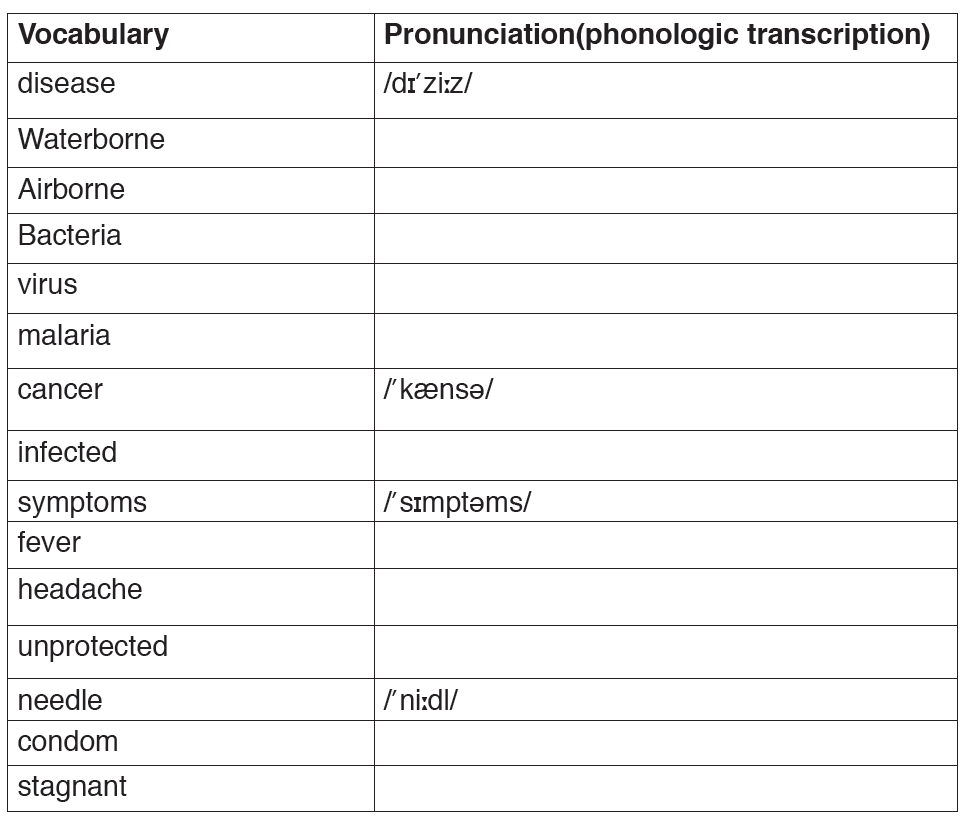
5.4 End unit assessment
i. Complete the Conditional Sentences using the correct form of verbs in brackets.
1. If we meet at 9:30, we……….plenty of time. (have)
2. Lisa would find the milk if she……….in the fridge. (look)
3. The zookeeper would have punished her with a fine if she…………the animals.(feed)
4. If you spoke louder, your classmates………………you.
(understand)
5. Dan…………safe if he drove slowly. (arrive)
6. You…………….no trouble at school if you had done your homework. (have)
7. If you………………in this lake, you’ll shiver from cold. (swim)
8. The door will unlock if you………………the green button. (press)
9. If Keza…………….her teacher, he’d have answered her questions. (ask)
10. I……………the office if I were you. (call)
ii. Choose the right word to fill in blanks in the following paragraph
Hepatitis B and C and HIV/AIDS are transmitted through body………(muscles/fluids). Infections and diseases, such as hepatitis are most often carried through the semen and blood of……………(infected/healthy) persons. Malaria is transmitted through the ………. (excrement/bite) of a female anopheles………… (fly/mosquito). It injects infected …….…(blood/semen) into your body when it bites you.
iii. Write a 200 word composition on a person you saw who got a communicable disease and use conditional sentences to explain what they would have done to avoid that communicable disease.
